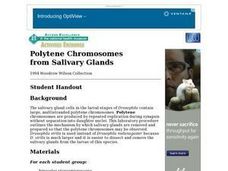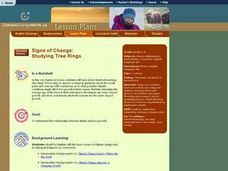Curated OER
Oolitic Sand: An Introduction
Fourth graders investigate the characteristics of different types of sand. They compare and contrast the types of sand by making observations with a dissecting microscope. Then students draw what is seen and include shape, color, and...
Curated OER
Layers of the Forest- Leaf Litter
Students conduct an experiment. For this temperate forest lesson, students discuss what kind of animal life can be found in the forest. They read The Magic School Bus Meets the Rot Squad: A Book About Decomposition and complete an...
Teach Engineering
Challenges of Laparoscopic Surgery
Get some laparoscopic training without the pain with an activity that challenges class members to find out what it is like to perform laparoscopic surgery. Teams perform three different tasks and quantify their performance. The activity...
University of Southern California
What Lives In The Ocean?
One of the most diverse environments on Earth is the ocean. Young scientists explore the living things found in the ocean during an exciting seven-lesson unit. Their study includes organisms from plankton to invertebrates and vertebrates...
Curated OER
Comparing Ionic and Polar Covalent Crystals
Twelfth graders make a number of ionic crystals. They compare a preserved snowflake to the physical properties of the ionic crystals. They apply qualitative observations and drawings in their discussion of the similarities between ice...
Curated OER
Observing the Development of Drosophila in Apple Juice Agar
Students observe the development of the Drosophila fly. They observe the first two stages - the egg and the 3 larval instars. They observe the culture every day for 8 days using a stereo dissecting microscope.
Curated OER
Human Epidermal Cells
Students explore epidermal cells. After following specified procedures for removing epidermal cells from their wrist, students view the cells with the use of a microscope. After creating a drawing of their observation, students label the...
Curated OER
Animal Organs and the Study of Reproduction, Embryology and Cancer
Students examine organs from dogs and cats to study reproduction, embryology, and the identification of cancer. They record their observations at both the gross and microscopic levels. They present their information to the class.
Curated OER
Flower Power
Students explore the parts of flowers and how they reproduce. They dissect flowers and observe the reproductive organs. Students observe anthers and ovaries of Tiger Lilies under a microscope. They investigate how insects and other...
Curated OER
Seed Types
Students dissect seeds. In this seed dissection instructional activity, students discover the anatomy of seeds. After dissecting seeds, students hypothesize and design the perfect seed to survive in a dry forest.
Curated OER
Pollinators and Wildflowers
Learners explore how plants depend on pollinators to reproduce. In this pollination lesson students dissect a local flower and collect and identify pollinating insects.
Curated OER
Plant Pollination
Students investigate methods of pollination for various flowers. In this plant biology lesson, students learn the parts of a flower and form a hypothesis about the method of pollination for the flower. They determine the validity of...
Curated OER
Plant Pollution
Students study the different parts of a flower and their functions. For this pollination lesson students study a flower under a microscope.
Curated OER
Elegant Embryology
Students observe embryogenesis in action through early stages of development of eggs. They observe cultures with dissecting and compound microscopes. They draw their egg, record any details and observe for changes. They compare their...
Curated OER
Exploring Food with Senses
Learners explore properties of fruits and vegetables using their five senses. For this sensory activity lesson, students study fruit and vegetables through a microscope, using their sense of touch as they are blindfolded, and with their...
Curated OER
Wacky Water Critters
Young scholars visit a local creek or stream. They collect water samples from the creek and observe and sort the "water critters" they find in the sample, observing smaller organisms under a microscope if necessary. They identify each...
Curated OER
Science: Bees: An Interdisciplinary Approach
Students investigate the world of bees and describe their characteristics. by identifying the bees' parts, they demonstrate how these parts function. In the lab, students dissect bees and view the various parts under microscopes. ...
Curated OER
Polytene Chromosomes from Salivary Glands
Students use this laboratory procedure to outline the mechanism by which salivary glands are removed and prepared so that the polytene chromosomes may be observed.Drosophila virilis is used instead of Drosophila melanogaster because D....
Curated OER
Honey Bee Anatomy and Identification
High schoolers examine and dissect a worker honey bee to analyze the structures and functions of honey bees. They draw the structures they see and compare/contrast them to drawings or electron micrographs.
Curated OER
Fish Parasite Survey
Students survey and dissect as many fish as possible. They count nematodes, cestodes and crustaceans on the fish, fill out autopsy reports, and transfer data to a chalkboard data table. Students graph the results of the entire class...
Curated OER
Are Fruits And Vegetables Really Made of Cells?
Students design and carry out an exercise to determine if a given fruit or vegetable is composed of cells. They dissect out sections of the fruit or vegetable, prepare stained slides, and make observations under a compound microscope.
University of Minnesota
C. elegans and the Search for Extraterrestrial Life
Introduce the topic of astrobiology in a unit that's out of this world. Biology scholars examine the search for extraterrestrial life by culturing roundworms, a species that has been key in helping researchers understand the challenges...
Curated OER
Signs of Change: Tree Rings
Students identify and experiment with dendrochronology (the study of tree rings to answer ecological questions about the recent past) and come up with conclusions as to what possible climatic conditions might affect tree growth in their...
Curated OER
Invertebrate Diversity
Comparative anatomy prevails in the lesson exploring diversity among invertebrates. Biologists examine physical characteristics of an earthworm from phylum annelida and a meal worm from phylum insecta. They also inspect a cricket and a...

























